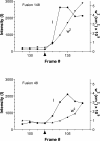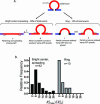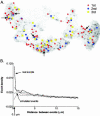Visualization of regulated exocytosis with a granule-membrane probe using total internal reflection microscopy
- PMID: 15282339
- PMCID: PMC519157
- DOI: 10.1091/mbc.e04-02-0149
Visualization of regulated exocytosis with a granule-membrane probe using total internal reflection microscopy
Abstract
Secretory granules labeled with Vamp-green fluorescent protein (GFP) showed distinct signatures upon exocytosis when viewed by total internal reflection fluorescence microscopy. In approximately 90% of fusion events, we observed a large increase in fluorescence intensity coupled with a transition from a small punctate appearance to a larger, spreading cloud with free diffusion of the Vamp-GFP into the plasma membrane. Quantitation suggests that these events reflect the progression of an initially fused and spherical granule flattening into the plane of the plasma membrane as the Vamp-GFP simultaneously diffuses through the fusion junction. Approximately 10% of the events showed a transition from puncta to ring-like structures coupled with little or no spreading. The ring-like images correspond quantitatively to granules fusing and retaining concavity (recess of approximately 200 nm). A majority of fusion events involved granules that were present in the evanescent field for at least 12 s. However, approximately 20% of the events involved granules that were present in the evanescent field for no more than 0.3 s, indicating that the interaction of the granule with the plasma membrane that leads to exocytosis can occur within that time. In addition, approximately 10% of the exocytotic sites were much more likely to occur within a granule diameter of a previous event than can be accounted for by chance, suggestive of sequential (piggy-back) exocytosis that has been observed in other cells. Overall granule behavior before and during fusion is strikingly similar to exocytosis previously described in the constitutive secretory pathway.
Figures







References
-
- Albillos, A., Dernick, G., Horstmann, H., Almers, W., Alvarez de Toledo, G., and Lindau, M. (1997). The exocytotic event in chromaffin cells revealed by patch amperometry. Nature 389, 509-512. - PubMed
-
- Ales, E., Tabares, L., Poyato, J.M., Valero, V., Lindau, M., and Alvarez de Toledo, G. (1999). High calcium concentrations shift the mode of exocytosis to the kiss-and-run mechanism.[comment]. Nat. Cell Biol. 1, 40-44. - PubMed
-
- Axelrod, D. (2001). Selective imaging of surface fluorescence with very high aperture microscope objectives. J. Biomed. Optics 6, 6-13. - PubMed
Publication types
MeSH terms
Substances
Grants and funding
LinkOut - more resources
Full Text Sources

